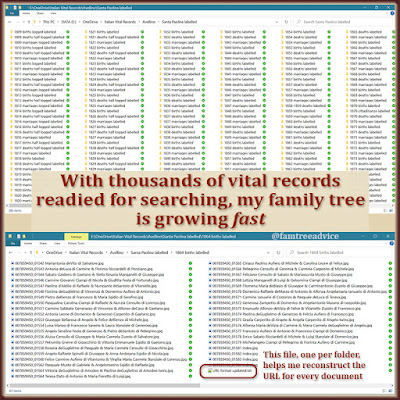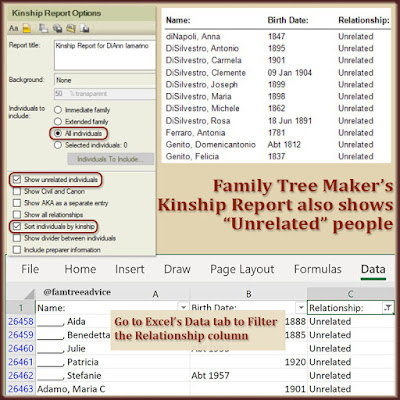When someone asks me to research their family tree, I pick out the key facts from what they've told me, and go to the available documents.
As an Italian-American, I know our ancestors "Americanized" their names to fit in. And I know many of us heard our ancestors came from Naples. It's my job as an Italian ancestry researcher to see past the changed names and look beyond Naples.
It was common for our immigrant ancestors to never speak of the old country. If your elders didn't mention their hometown by name, you likely don't know where they were born.
Genealogy documents hold the clues you need. Your ancestor's immigration record may name their hometown. If not, you can search for naturalization records. Also check World War I and II draft registration cards. While one of these may tell you only the country of birth, the other may have the exact town name.
 |
| I can plot ALL my ancestors on a thin strip of a souvenir map from Italy. It took a bunch of documents to make this happen. |
But Where, Exactly?
My Sarracino and Saviano ancestors are a perfect example of using documents. My grandmother and her sister told me their family came from two places: Pastene and Avellino. When I began to research, those two specific places became a problem.
Looking at Google Maps, I found Pastena, which is what I thought I heard. And there was a big Sarracino family from the town. After adding the wrong family to my tree, I learned they were not my family. And when I looked for Avellino on the map, I found it was both a city and a province. Imagine if you knew your family was from New York, but you didn't know if that meant the city or the state. Big difference!
It was the documents that set things straight. I found the 1899 ship manifest for my Sarracino and Saviano great grandparents. The hometown written on the manifest was Sant'Angelo a Cupolo. Checking the map again, I found a hamlet within Sant'Angelo a Cupolo called Pastene. Pastena/Pastene—a one-letter difference. The two places are in different provinces, which makes a world of difference. They store the vital records for each province separately. And they're filed separately online.
Having solved the Pastene mystery, I didn't know where Avellino came into play. If both my great grandparents were from Pastene, who came from Avellino?
Another genealogy document to the rescue! My great granduncle's World War II draft registration card had the answer. They misspelled the town, but the map made it clear. He was born in Tufo, a small town in the province of Avellino.
I followed the document trail in Tufo and found a surprise. My 2nd great grandmother Colomba wasn't from Tufo. She was from the neighboring town of Santa Paolina. She and her father's ancestors all came from Santa Paolina. One more document, a death record for Colomba's mother, held another surprise. My 3rd great grandmother was from Apice, a town in the Benevento province.
Think about that for a moment. The oral history said my family was from Pastena and Avellino. The documents showed me this part of my family actually came from:
- Pastene (part of Sant'Angelo a Cupolo in Benevento)
- Santa Paolina in Avellino
- Apice in Benevento.
You've got to follow the documents.
 |
| Grandma didn't lie. But your family's word-of-mouth history is a lot like a game of "telephone". |
Two Proud Grandpas and One Strong Accent
Two of my ancestral hometowns were always a given. My two immigrant grandfathers were proud to say where they were born. I've known this all my life: one was from Baselice and the other was from Colle Sannita, both in Benevento.
There was only one more hometown I needed to identify. My Caruso great grandmother met my great grandfather in upstate New York. I didn't know where she was born. I connected with my Dad's first cousin June who grew up with her grandmother. She said my great grandmother was also proud of her hometown. With my great grandmother's Italian accent, the hometown sounded like Pisqualamazza.
First I checked the map. Pisqualamazza is not a town. Then I had an idea. I checked Ancestry.com for immigrants named Caruso. Yes, that's a common name. But I was searching for a hometown that looked something like Pisqualamazza.
It hit me like a thunderbolt. I found a Caruso from the town of Pescolamazza. I can totally understand how Pesco could sound like Pisqua. There was only one problem. Pescolamazza also isn't on the map.
A regular Google search for Pescolamazza explained it all. The name of the town evolved over the centuries:
- Pesclum
- Pesco
- Piesco
- Lo Pesco
- Lo Pesco de la Macza
- Pescolamazza
- and in 1947: Pesco Sannita
At last I found my great grandmother's hometown: Pesco Sannita, also in Benevento.
You can't find your immigrant ancestor's birth record if you don't know their town. Use the documents you can find to pin down the town of birth. Identifying the towns and accessing their vital records is why my family tree has 30,000 people.
So, keep the oral history in mind, but follow the documents!








